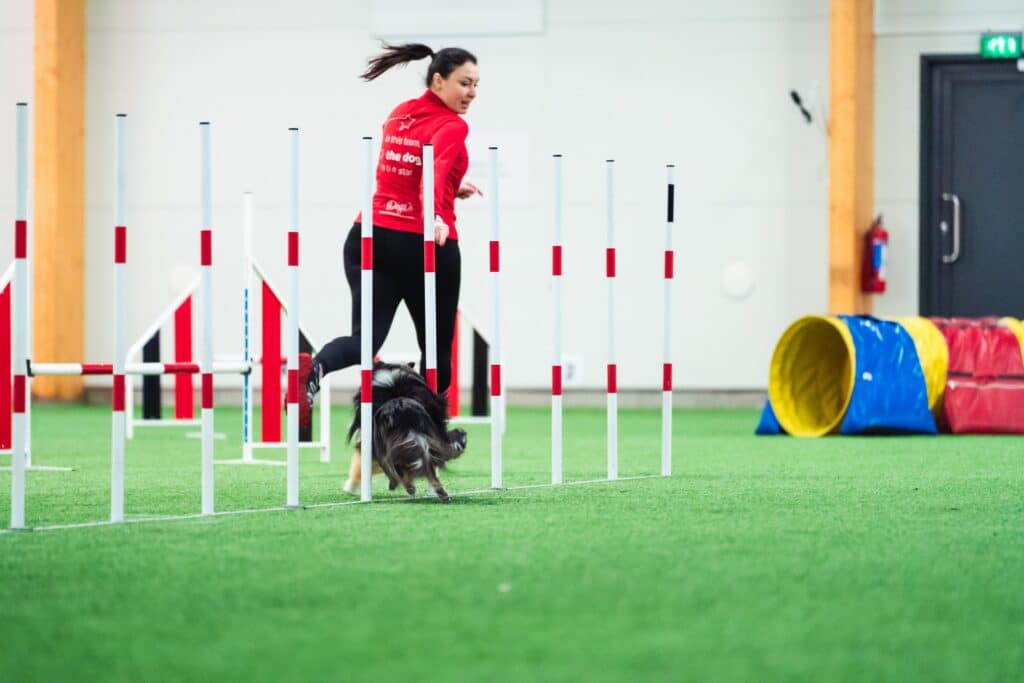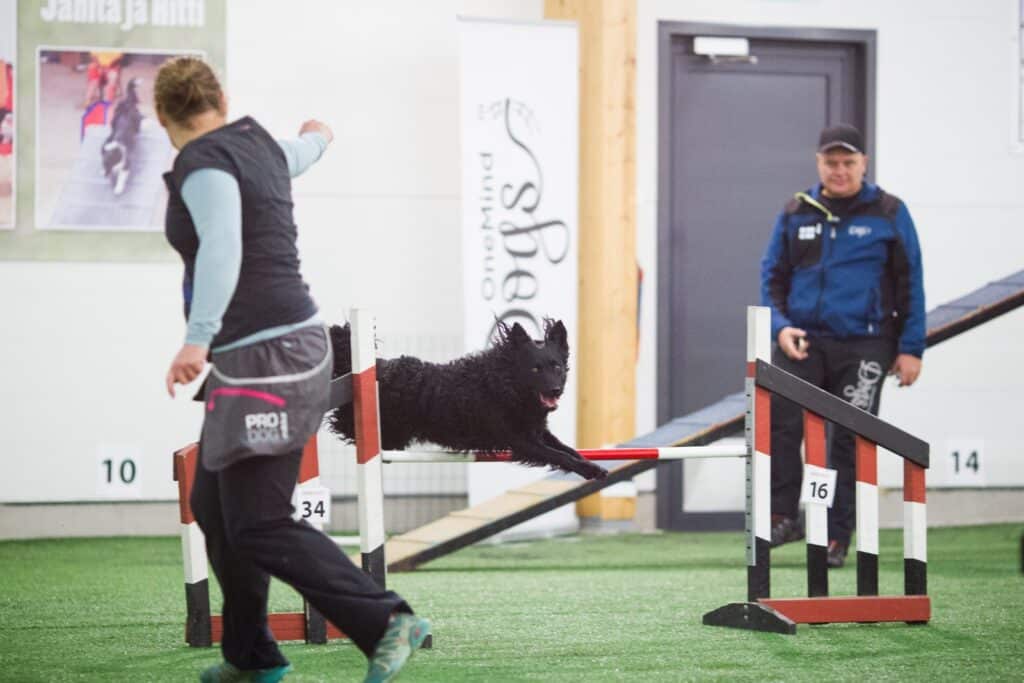Agility is all about teamwork. You and your dog run the course together, aiming to navigate tricky sequences with efficiency and flow. But behind every smooth run lies a balance that can make or break your success: the balance between obstacle focus and handler focus.
At OneMind Dogs, our coaches often talk about this balance as one of the most important skills for agility teams. If your dog is too focused on obstacles, they may rush off-course and leave you behind. If they’re too focused on you, they may hesitate and need extra support, slowing the run and needing you to run up to every obstacle. Finding the right mix allows your dog to confidently perform obstacles while still responding to your cues.
Let’s dive deeper into why this balance matters, what influences it, and how you can shape it in your own training.
What obstacle focus and handler focus mean
Obstacle focus is your dog’s natural drive to move forward and take the next obstacle they see. Dogs with high obstacle focus love working ahead, spotting the course, and powering on with little hesitation.
Handler focus is your dog’s tendency to look back at you for guidance. Handler focused dogs often stay close, checking in to see where you want them to go next. They turn more easily, because their natural instinct is to come toward you rather than lock onto the next obstacle, but they are difficult to send ahead.
Neither one is “better” than the other. Both are essential. A dog with extreme obstacle focus may blast through a tunnel you didn’t mean for them to take. A dog with extreme handler focus may circle back toward you instead of driving forward.
Janita Leinonen, one of our founding coaches, sums it up beautifully:
“The higher the obstacle focus your dog has, the stronger cues you will need to keep your dog from taking every obstacle he sees. The higher the handler focus, the less likely your dog is to go to obstacles without handling and support.”
The magic lies in balancing the two.

Why balance is key
When your dog has just the right mix of obstacle and handler focus, you’ll notice a smoother, more natural teamwork.
- Your dog advances independently. They don’t need you to babysit every obstacle. They drive forward confidently, which helps your runs flow faster.
- Your cues matter more. Instead of ignoring you in their rush for obstacles or staring at you for every step, your dog is tuned in enough to catch your signals without slowing down.
- Turns are cleaner. High handler focus dogs naturally turn tighter because they want to come back toward you. Blending this into a forward-driving mindset creates efficient, responsive turns.
- The run feels easier. You don’t need to over-handle or constantly shout. The dog understands the course and your role becomes guiding, not dragging.
Jaakko Suoknuuti, founding OneMind Dogs coach, explains it like this:
“We emphasize obstacle focus because we think the dog’s main work in agility is to perform obstacles and advance on the course independently towards the next obstacle. This way the dog can help the handler and the team is able to advance more quickly.”
Learn more about achieving this balance in our webinar: Finding the balance: Obstacle vs handler focus in dog agility
The 60/40 sweet spot
So what’s the “right” balance? At OneMind Dogs, we often aim for about 60% obstacle focus and 40% handler focus.
That extra push toward obstacle focus gives your dog the drive to work ahead, spot lines, and commit to challenges. It also makes distance handling much easier. But the 40% handler focus ensures they’re still connected to you, ready to respond to subtle cues.
Janita explains the process:
- In the beginning: Aim for very high obstacle focus, even up to 90%. Let your dog offer obstacle behaviors naturally and reward mostly on the line or behind the obstacle instead of from your hand. This builds independence and teaches your dog to seek out the next challenge.
- Later on: Once obstacle focus is solid, you can reduce it slightly. Begin rewarding more from your hand or in situations that bring your dog closer to you. This sharpens handler focus so your cues cut through when you need a turn or collection.
By training in this order, you build a forward-thinking dog first and then add responsiveness. It’s easier to bring obstacle focus down than to build it up later. Check out our online learning theme on this topic to learn more.
How training shapes focus
Every dog has their own natural tendencies based on character and genetics. Some love to seek out obstacles, others prefer to stick close to their handler. But the way you teach and reward plays a huge role in shaping that balance.
- Reward placement matters. If you want more obstacle focus, reward behind the obstacle or on the line forward. If you want more handler focus, reward from your hand or in collection near you.
- Course design builds habits. Training sequences where your dog can drive ahead without constant support strengthens obstacle focus. Adding exercises where they need to check in or come back toward you increases handler focus.
- Consistency counts. Your dog learns from every repetition. If they always get rewarded at your side, handler focus will dominate. If they always find the next toy or food reward ahead, obstacle focus will dominate. A mix of both develops balance.
Common challenges
As you work toward balance, you may run into some familiar issues:
- Dog ignores obstacles and stares at you. This is handler focus dominating. Increase obstacle rewards and let your dog offer more behaviors without constant cues.
- Dog blasts through obstacles and misses turns. This is obstacle focus dominating. Add more rewards from your hand, reward tight turns, and emphasize collection.
- Dog prefers work over food or toys. Some dogs are so motivated by the game itself that they don’t value rewards as much. In these cases, finding the right motivator or using play as reinforcement is key.

How to start balancing focus
If you’re just starting agility, don’t worry, this isn’t something you need to perfect right away. Instead, keep these tips in mind:
- Build obstacle focus early. Encourage your dog to seek out jumps, tunnels, and contacts independently.
- Reward thoughtfully. Think about where you’re placing the reward. Each choice shapes future behavior.
- Gradually add handler focus. Once your dog is confidently driving ahead, start layering in exercises that require checking in with you.
- Stay consistent. Make sure everyone training your dog uses the same reward strategy.
- Train both sides. Practice sequences where your dog drives forward and ones where they need to come back toward you.
The bigger picture
Balancing obstacle and handler focus isn’t just about agility runs. It’s about creating a stronger understanding between you and your dog.
At OneMind Dogs, our mission is to help people see the world from their dog’s perspective. When you understand how your dog reads the course and responds to rewards, you can shape their learning in a way that feels natural to them. The result is not only smoother runs, but also a happier dog who enjoys working with you.
Final thoughts
Think of obstacle focus and handler focus like two sides of the same coin. You need both for agility to work. Too much of one makes the run harder, but when the balance is right, you’ll feel the flow of true teamwork.
Start with strong obstacle focus, add handler focus when your dog is ready, and use reward placement as your guide. With practice, you’ll find that sweet spot where your dog drives forward with confidence while still staying tuned in to you.
That’s when agility becomes truly effortless. Learn more about achieving this balance in our webinar: Finding the balance: Obstacle vs handler focus in dog agility
https://www.oneminddogs.com/blog/balancing-obstacle-focus-handler-focus-dog-agility/
